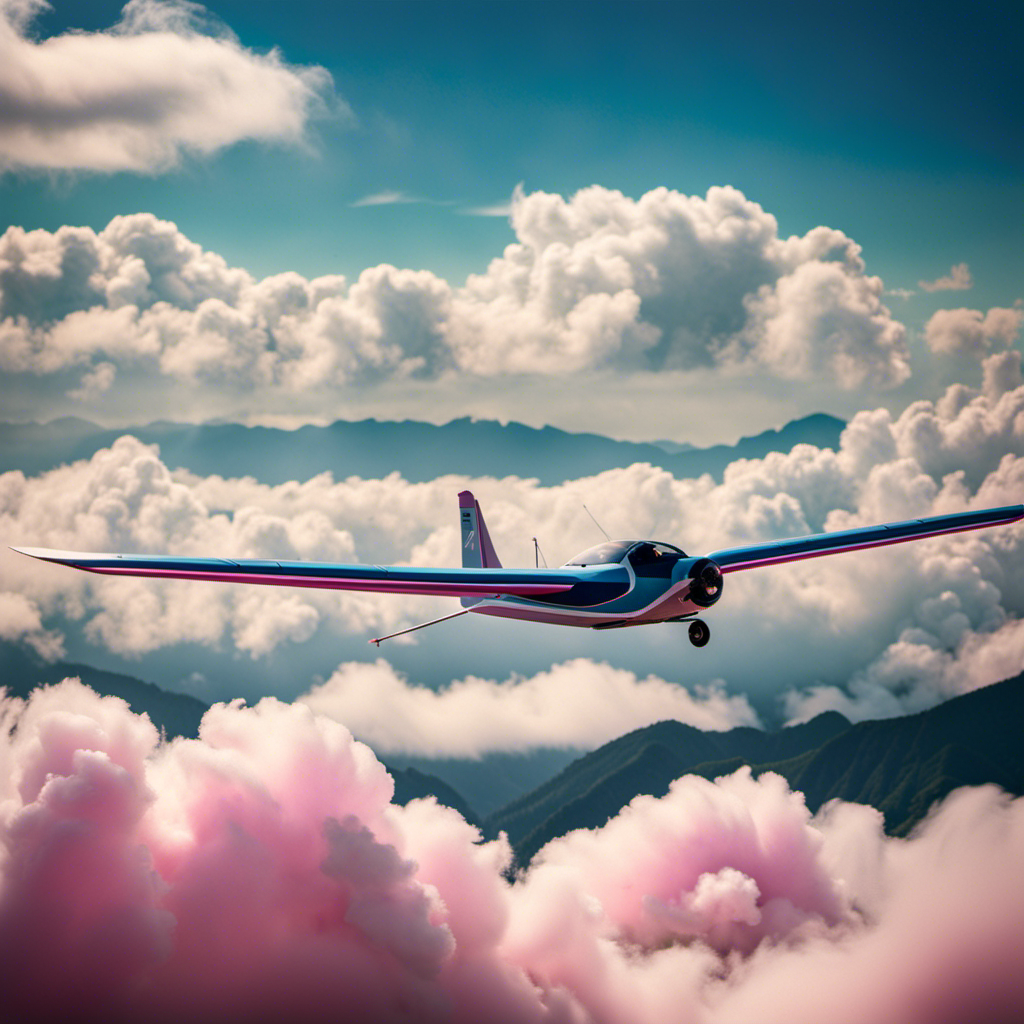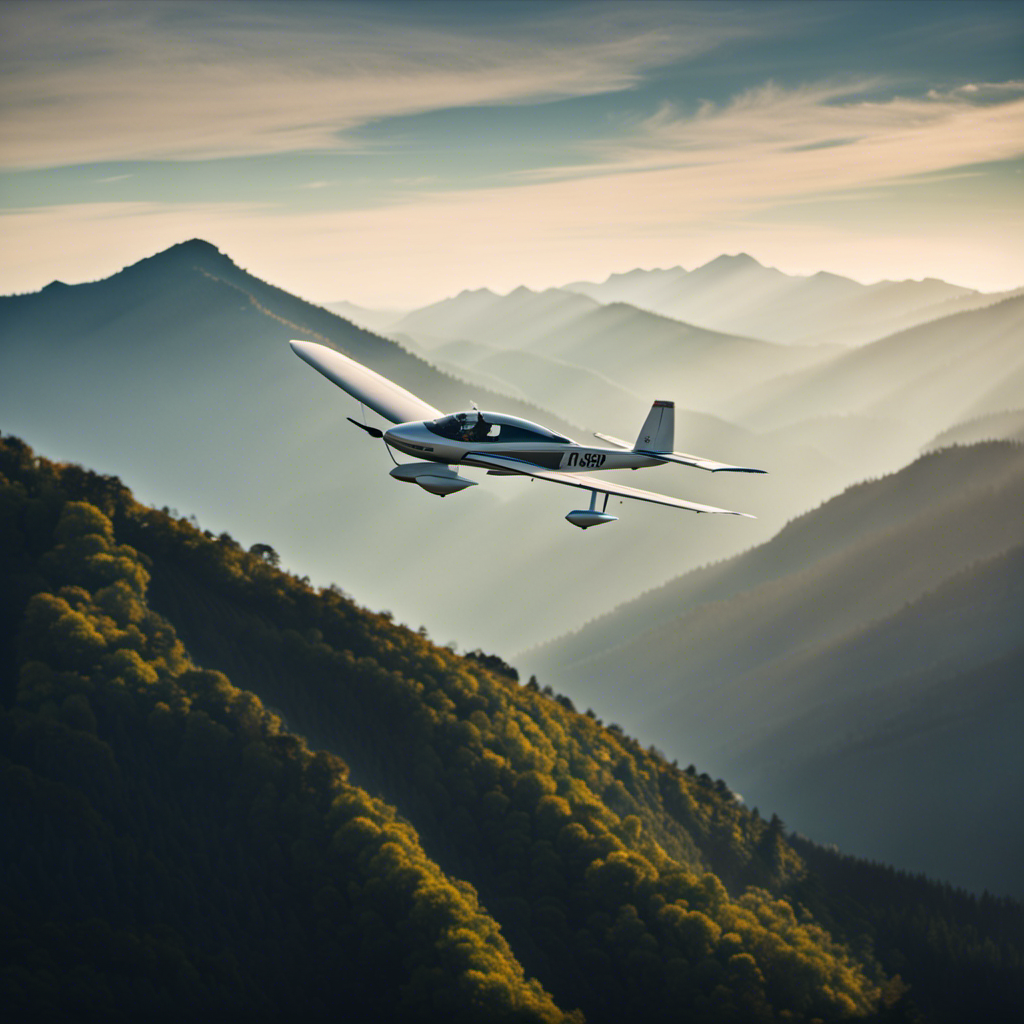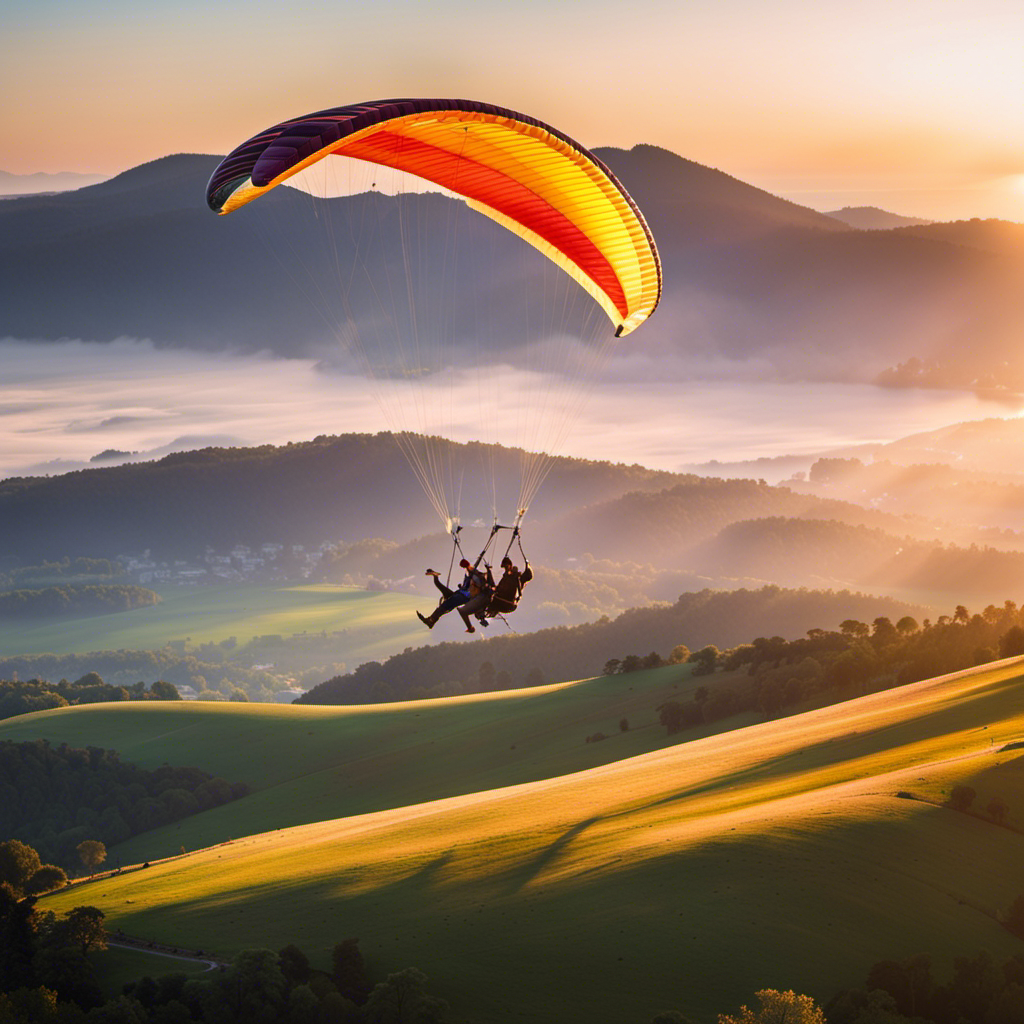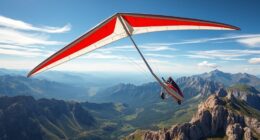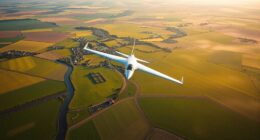As I glide through the sky, free and liberated, I am amazed by the beauty of flying.
Have you ever wondered if you could go around in a glider? Well, wonder no more. In this article, I will delve into the world of glider flying, exploring the basics, the experience, and the myths surrounding this exhilarating activity.
So strap in and join me on this journey as we uncover the secrets of gliding and unlock the potential of the skies.
Key Takeaways
- Gliders rely on natural forces for flight and do not have an engine.
- Glider controls include elevator, ailerons, and rudder, and understanding aerodynamics is crucial for successful soaring.
- Gliders can take off via aerotow, winch launch, or self-launch, and landing requires precise control and timing.
- Gliding techniques such as thermalling, ridge soaring, and wave soaring maximize efficiency and enable long flights.
What is Gliding?
Gliding is a type of aviation where an aircraft flies without an engine. It relies on the natural forces of the atmosphere to stay aloft and maintain its forward momentum. Exploring glider aerodynamics is essential to understanding how these aircraft achieve flight.
Gliders are designed to be highly efficient, with sleek, streamlined shapes and long, narrow wings. This allows them to generate lift and minimize drag, maximizing their ability to stay airborne.
The benefits of gliding for pilots are numerous. It offers a unique and challenging flying experience, allowing pilots to hone their skills in reading the weather, understanding wind patterns, and making strategic decisions. Gliding also provides a deeper connection with nature and a sense of freedom, as pilots navigate through the sky with minimal noise and pollution.
With this understanding of gliding, let’s now delve into the basics of glider flying.
The Basics of Glider Flying
When it comes to glider flying, there are three key points to consider: how do gliders stay in the air, how do gliders take off and land, and what controls the glider.
Gliders stay in the air by utilizing the principle of lift, which is achieved by the shape of their wings and the air currents.
During takeoff, gliders are towed into the air by a powered aircraft, or they can be launched from a high point like a hill or a winch.
Once in the air, the glider is controlled by the pilot through the use of various controls, including the elevator, ailerons, and rudder.
How Do Gliders Stay in the Air?
One of the ways gliders stay in the air is by utilizing rising air currents called thermals. These thermals are created by the sun heating the Earth’s surface, causing the air to rise. As the glider flies through a thermal, it gains altitude, allowing it to stay airborne for extended periods.
Soaring techniques, such as ridge soaring and wave soaring, also help gliders stay aloft. Ridge soaring involves flying along the slope of a hill or mountain, using the upward wind generated by the terrain. Wave soaring occurs when strong winds encounter a mountain range, creating a series of standing waves that can lift a glider to great heights.
Understanding the aerodynamics of gliders and how to exploit these natural phenomena is crucial for successful and efficient soaring.
Now that we understand how gliders stay in the air using these techniques, let’s explore how they take off and land without the use of an engine.
How Do Gliders Take Off and Land?
To take off in a glider, you’ll need to be towed into the air by a powered aircraft. Once you’re airborne, the glider pilot can release the tow rope and begin soaring. Here are some key techniques for glider takeoff and landing:
- Aerotow: The glider is connected to a powered aircraft by a tow rope, which pulls it into the air until it reaches a safe altitude.
- Winch Launch: A winch on the ground rapidly reels in a cable, launching the glider into the air.
- Self-Launch: Some gliders have their own engines, allowing them to take off independently.
During landing, the pilot must master the art of glider control to execute a safe touchdown. This involves using a combination of airbrakes, spoilers, and flaps to control the glider’s descent and speed. Additionally, precise timing and skillful maneuvering are crucial to achieve a smooth landing.
Now, let’s explore what controls the glider without writing ‘step’.
What Controls the Glider?
Using the control stick and rudder pedals, you’ll be able to steer the glider and maintain stability in flight. Glider controls are essential for maneuvering and controlling the aircraft.
The control stick, located between the pilot’s legs, is used to control pitch and roll. Pushing the stick forward or pulling it back adjusts the pitch, which controls the glider’s nose-up or nose-down attitude. Moving the stick left or right controls the roll, allowing the glider to bank and turn.
The rudder pedals, located on the cockpit floor, control the yaw. Pressing the left or right pedal adjusts the rudder, which helps the glider to turn left or right.
Understanding the aerodynamics of gliders and how the controls interact with the airflow is crucial for a safe and successful flight.
Now, let’s explore whether it’s possible to go around in a glider.
Can You Go Around in a Glider?
When it comes to exploring the capabilities of gliders, one cannot overlook the importance of understanding soaring and thermal lift. These phenomena play a crucial role in allowing gliders to stay aloft for extended periods of time without the need for a motor.
Additionally, gliding competitions and long-distance flights showcase the impressive skills of glider pilots as they navigate through various weather conditions and terrain, pushing the boundaries of what is possible in this exhilarating form of aviation.
Exploring the Capabilities of Gliders
You can experience the incredible capabilities of gliders firsthand. Gliders are remarkable aircraft that rely on the principles of aerodynamics to stay aloft and navigate through the air.
Exploring glider aerodynamics is essential to understanding how these machines can achieve such impressive feats. Gliding techniques and strategies play a crucial role in maximizing the efficiency and performance of gliders. By utilizing various techniques, such as thermalling and ridge soaring, glider pilots can stay airborne for extended periods and cover long distances.
Mastering these strategies requires a deep understanding of the physics behind gliding and the ability to make precise adjustments to control surfaces. Soaring and thermal lift are integral aspects of glider flight, and understanding their mechanics is key to successful gliding.
Understanding Soaring and Thermal Lift
Understanding the mechanics of soaring and thermal lift is crucial for successful gliding. Here are four key elements to consider when it comes to soaring techniques, thermals, and wind patterns:
-
Locating thermals: Thermals are columns of rising warm air that gliders can use to gain altitude. Look for signs such as cumulus clouds, birds circling, or dust devils.
-
Entering thermals: When you find a thermal, enter it by circling in a tight, coordinated turn. This allows the glider to stay within the rising air mass and gain altitude effectively.
-
Maximizing lift: To maximize lift, adjust the glider’s bank angle and airspeed. Finding the right balance is crucial to staying within the thermal and gaining altitude efficiently.
-
Utilizing wind patterns: Wind can create ridge lift or wave lift, which are alternative sources of lift for gliders. Understanding wind patterns and using them strategically can enhance your gliding experience.
Gliding Competitions and Long-Distance Flights
To increase your chances of success in gliding competitions and long-distance flights, it’s essential to master techniques such as maximizing lift and utilizing wind patterns strategically.
In gliding competitions, pilots compete against each other in various tasks, including distance flights, speed races, and navigation challenges. These events require a deep understanding of aerodynamics and meteorology, as well as precise control of the glider.
Long-distance flights, on the other hand, require careful planning and execution to cover vast distances using minimal energy. Pilots must carefully analyze weather conditions, identify thermals and other sources of lift, and make strategic decisions to optimize their flight path.
By combining technical expertise with a strategic mindset, glider pilots can excel in both competitions and long-distance flights, pushing the boundaries of what is possible in the world of gliding.
Transitioning from the technical aspects of gliding to the experience of being in the air, the feeling of soaring through the sky in a glider is truly exhilarating.
The Experience of Gliding
The experience of gliding in a glider is incredibly peaceful and exhilarating. As I soar through the sky, I feel a sense of freedom unlike anything else. Gliding techniques and equipment play a crucial role in making this experience possible. Let me paint a picture for you with a table illustrating the essential equipment used in gliding:
| Equipment | Description | Purpose |
|---|---|---|
| Glider | Light, aerodynamic aircraft | Provides lift and sustains flight |
| Parachute | Safety device | Emergency use in case of a mishap |
| Altitude Indicator | Instrument | Helps determine height above ground |
| Variometer | Instrument | Indicates rate of ascent or descent |
Learning to glide is an exciting journey that involves mastering these techniques and using the right equipment. It’s a process that requires dedication and practice, but the rewards are well worth it. Now, let’s delve into the joys of learning to glide.
Learning to Glide
Learning how to glide is an exhilarating and rewarding journey that requires dedication and practice.
Exploring glider aerodynamics is a crucial part of mastering this skill. Understanding how the glider moves through the air and harnessing the forces acting upon it is essential for efficient and controlled gliding.
Additionally, mastering glider navigation is vital for safely maneuvering through the skies. Learning how to read the weather conditions, identifying thermals and other lift sources, and effectively planning and executing a flight path are all key components of glider navigation.
By honing these skills, glider pilots can navigate their way through the sky with precision and confidence.
Transitioning into the subsequent section about safety measures in gliding, it is important to note that while exploring the world of gliding is exciting, it is equally important to prioritize safety.
Safety Measures in Gliding
Understanding weather conditions, emergency procedures, and safety equipment is crucial for ensuring safety in gliding. By comprehending weather patterns and conditions, pilots can make informed decisions about when it is safe to fly and when to stay grounded.
Being well-versed in emergency procedures and having access to proper safety equipment can prevent accidents and minimize potential harm. Pilots should be familiar with the necessary steps to take in case of an emergency and have the necessary equipment readily available.
Lastly, implementing effective risk management strategies and accident prevention measures can further enhance safety in gliding operations. Pilots should be proactive in identifying potential risks and taking appropriate measures to mitigate them.
Overall, a comprehensive understanding of weather conditions, emergency procedures, safety equipment, and risk management is essential for ensuring safety in gliding.
Understanding Weather Conditions
Yes, you’ll need to check the weather conditions before going around in a glider. Understanding weather patterns is crucial for a safe and successful flight. Here are three key factors to consider when reading wind currents:
-
Wind direction: Assess the prevailing wind direction at various altitudes. This will help you determine the best routes and avoid potential turbulence.
-
Wind speed: Analyze the wind speed to gauge its impact on the glider’s performance. Strong winds can provide lift, but excessive gusts can be dangerous.
-
Cloud formations: Observe the type and movement of clouds, as they can indicate changes in air pressure and potential thermal activity.
By understanding these weather patterns and wind currents, you can make informed decisions during your gliding adventure.
Now, let’s delve into the emergency procedures and safety equipment necessary for a safe gliding experience.
Emergency Procedures and Safety Equipment
Before taking off in a glider, it’s important to familiarize yourself with the emergency procedures and safety equipment. In the event of an emergency landing, knowing what to do can mean the difference between life and death. Safety protocols should always be followed to minimize the risk of injury.
First and foremost, make sure you are wearing the appropriate safety gear, including a helmet and harness. Familiarize yourself with the location and operation of the emergency parachute, as this can be crucial in case of a catastrophic failure. Additionally, learn how to quickly and safely exit the glider in case of an emergency.
By understanding these emergency procedures and having the necessary safety equipment, you can greatly enhance your chances of surviving a potential disaster.
Now, let’s move on to the next section, which focuses on risk management and accident prevention.
Risk Management and Accident Prevention
To effectively manage risks and prevent accidents, it’s important to follow safety protocols and be aware of potential hazards. Here are some key points to consider when it comes to risk management and accident prevention in gliding:
-
Conduct a thorough risk assessment before each flight to identify potential hazards and assess their likelihood and severity.
-
Implement appropriate safety measures and protocols based on the identified risks, such as pre-flight inspections, equipment checks, and adherence to flight rules and regulations.
-
Ensure proper training and proficiency of pilots to minimize human error and enhance situational awareness.
-
Regularly review and update safety procedures based on accident investigation findings to continuously improve safety standards.
By prioritizing risk management and accident prevention, we can ensure a safer and more enjoyable experience in gliding as a hobby or sport.
It’s crucial to stay vigilant and proactive in minimizing risks to maximize the overall safety of gliding activities.
Gliding as a Hobby or Sport
When it comes to gliding as a hobby or sport, there are several key points to consider.
First, joining a gliding community is a great way to connect with like-minded individuals and learn from experienced pilots.
Second, participating in gliding competitions can provide a thrilling and competitive aspect to the sport, allowing you to test your skills against other pilots.
Joining a Gliding Community
If you want to join a gliding community, you should reach out to local gliding clubs in your area. Being a part of a gliding club offers numerous benefits and opportunities for gliding enthusiasts.
Here are three reasons why joining a gliding club is a great idea:
-
Camaraderie: Gliding clubs foster a sense of community and camaraderie among members. You’ll have the chance to connect with like-minded individuals who share your passion for gliding, creating lifelong friendships.
-
Skill Development: Gliding clubs provide access to experienced pilots and instructors who can help you improve your skills. Whether you’re a beginner or an experienced glider, there’s always something new to learn and ways to enhance your flying abilities.
-
Access to Resources: Gliding clubs often have well-maintained gliders and facilities that you can utilize. This means you can enjoy gliding as a recreational activity without the need to invest in your own glider.
Participating in Gliding Competitions
Participating in gliding competitions can be a thrilling and challenging experience for gliding enthusiasts. It requires a combination of skill, strategy, and mental preparation. When preparing for a gliding competition, it is important to explore different gliding techniques that can help improve your performance. This includes mastering the art of thermalling, ridge soaring, and navigating cross-country flights. Mental preparation is equally important, as staying focused and calm during the competition can make a significant difference. Visualizing the flight, setting achievable goals, and developing a pre-competition routine are some effective ways to prepare mentally. To give you an idea of what a gliding competition entails, here is a table highlighting key aspects of gliding competitions:
| Aspect | Description |
|---|---|
| Competition | A race against the clock |
| Scoring | Points based on distance |
| Tasks | Set routes to be flown |
| Weather | Influences flight strategy |
| Safety Measures | Implemented for all pilots |
Exploring different types of gliding allows enthusiasts to expand their knowledge and experience in the sport.
Exploring Different Types of Gliding
Exploring different types of gliding can broaden enthusiasts’ knowledge and experience in the sport. One area that avid gliders can focus on is mastering different soaring techniques. These techniques involve using the natural elements, such as thermals, ridge lift, and wave lift, to gain altitude and extend flight time.
Learning how to identify and utilize these soaring techniques effectively can significantly enhance a pilot’s ability to stay aloft and cover longer distances. Another type of gliding that enthusiasts can delve into is cross country gliding. This involves plotting a course and flying from one location to another, relying on thermals and other lift sources to maintain altitude and progress towards the destination.
By exploring these different types of gliding, pilots can expand their skills and embrace the challenges of more advanced and adventurous flights.
As we transition into the subsequent section about glider technology and innovation, it becomes evident that these techniques and experiences also drive advancements in glider design and performance.
Glider Technology and Innovation
I’ve always been fascinated by the advancements in glider design and materials. These advancements have played a crucial role in improving the performance and safety of gliders. From the development of stronger and lighter materials to the implementation of innovative aerodynamic designs, gliders have achieved higher speeds, longer flight times, and increased maneuverability.
In addition, the emergence of electric gliders has paved the way for sustainable flying. This reduces reliance on fossil fuels and minimizes the environmental impact of gliding.
Looking towards the future, there are exciting possibilities for gliding. These include the integration of autonomous systems, the use of advanced propulsion technologies, and the exploration of new flying techniques.
Advances in Glider Design and Materials
Are you aware of the recent advancements in glider design and materials? As a passionate glider pilot, I am constantly amazed by the innovative developments in this field.
Here are some notable advancements that have revolutionized glider design and performance:
-
Composite Materials: The use of advanced composites, such as carbon fiber and Kevlar, has significantly reduced the weight of gliders while maintaining structural integrity.
-
Wing Design: Improved wing profiles and increased aspect ratios have enhanced lift and glide ratios, allowing gliders to soar for longer periods.
-
Cockpit Ergonomics: Modern gliders now feature ergonomically designed cockpits with adjustable seats, controls, and instruments for enhanced pilot comfort and safety.
-
Aerodynamic Innovations: Advancements in aerodynamics, including winglets and boundary layer control systems, have reduced drag and improved overall performance.
These advancements in glider design and materials have paved the way for the next exciting step in sustainable flying – electric gliders.
Electric Gliders and Sustainable Flying
With advancements in technology, electric gliders have become a sustainable option for eco-friendly flying. By utilizing electric propulsion instead of traditional engines, these gliders significantly reduce their environmental impact. Electric gliders are powered by batteries, which can be charged using renewable energy sources such as solar power. This eliminates the need for fossil fuels and reduces emissions, making electric gliders a cleaner alternative for aviation enthusiasts. To emphasize the benefits of electric gliders, consider the following table:
| Electric Glider Advantages |
|---|
| 1. Reduced emissions |
| 2. Lower noise pollution |
| 3. Decreased fuel costs |
| 4. Longer flight duration |
Electric gliders not only provide a quieter and more peaceful flying experience, but they also have longer flight durations due to the efficiency of electric propulsion. With ongoing research and development, future possibilities for gliding include advancements in battery technology, allowing for even longer flights and increased sustainability.
Future Possibilities for Gliding
To explore future possibilities for gliding, consider how advancements in battery technology could revolutionize the duration and sustainability of electric-powered flights. With the rapid development of future technologies, autonomous gliders could become a reality. Imagine a glider that can fly for extended periods without the need for a tow plane or thermal updrafts.
With improved battery technology, electric-powered gliders could stay aloft for hours, opening up new possibilities for long-distance flights and exploration. These advancements would not only make gliding more accessible but also reduce the environmental impact of traditional gliders, as they would no longer rely on fossil fuels.
As we look to the future, the potential for autonomous gliders and sustainable electric-powered flights is truly exciting. Now, let’s turn our attention to some of the famous gliding locations and events around the world.
Famous Gliding Locations and Events
Have you ever visited the famous gliding locations and events around the world? Gliding is a thrilling sport that attracts enthusiasts from all corners of the globe.
One of the most renowned gliding locations is the Omarama Glider Airfield in New Zealand. Known for its stunning scenery and consistent weather conditions, it offers an unforgettable experience for glider pilots.
Another popular destination is the Mifflin County Airport in Pennsylvania, USA. It hosts the annual Ridge Soaring Glider School, where pilots can learn from experienced instructors and participate in exciting glider events.
These locations and events provide opportunities for glider pilots to showcase their skills and compete against each other.
Now, let’s move on to debunking some common gliding myths and misconceptions.
Gliding Myths and Misconceptions
When it comes to gliding, safety is always a top concern. Many people have misconceptions about the safety of gliders, often assuming that they are at a higher risk due to their lack of an engine. However, this is far from the truth.
Gliders are designed with safety in mind and are subject to strict regulations and inspections. In fact, gliders have an excellent safety record, with accidents being quite rare.
One common misconception is that gliders cannot fly in bad weather conditions. While it is true that gliders are more limited in adverse weather, experienced pilots can safely navigate through various weather conditions, including rain and wind. Gliders are equipped with instruments that provide valuable information about weather patterns, allowing pilots to make informed decisions and ensure the safety of their flights.
Frequently Asked Questions
How much does it cost to go gliding?
The cost of gliding varies depending on location and duration. Popular gliding locations include the Alps, New Zealand, and California. Compared to other aviation pursuits, gliding can be a more cost-effective option.
Are there any age restrictions for gliding?
Age restrictions for gliding vary depending on the country and gliding club. Safety measures such as height and weight restrictions, medical examinations, and training programs are in place to ensure a safe and enjoyable experience for all.
What kind of weather conditions are suitable for gliding?
Thermal updrafts and ridge lift are ideal weather conditions for gliding. Thermal updrafts are columns of warm air that can lift a glider, while ridge lift occurs when wind is forced upwards by a ridge of high ground.
Is a gliding license required to fly a glider?
Yes, a gliding license is required to fly a glider. Glider regulations focus on ensuring safety in flight. For example, a pilot must demonstrate proficiency in glider control and understanding of emergency procedures before obtaining a license.
Can you perform aerobatic maneuvers in a glider?
Yes, you can perform aerobatic maneuvers in a glider. However, it is important to prioritize glider safety and adhere to proper training and guidelines. The benefits of gliding include improved flying skills and a thrilling experience.
Conclusion
In conclusion, gliding is a thrilling and exhilarating experience that allows you to soar through the sky without the need for an engine. With the right training and practice, anyone can learn to glide and enjoy the freedom of flight.
Whether you choose to pursue gliding as a hobby or a sport, there are endless opportunities to explore the world from above.
So why wait? Take to the skies and let your dreams take flight, like a bird soaring on the wind.
